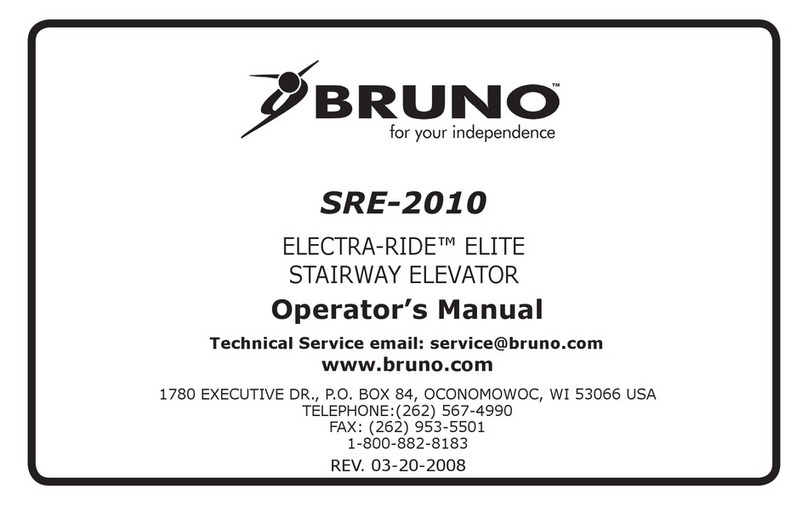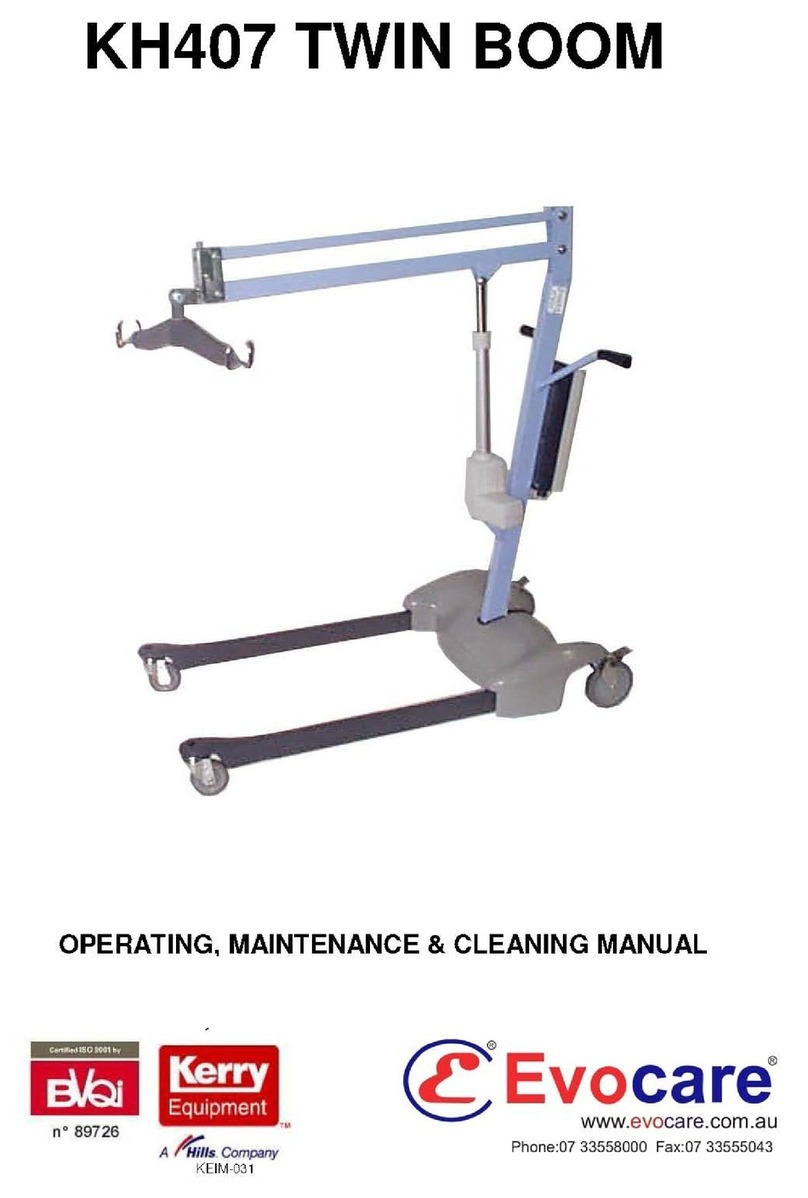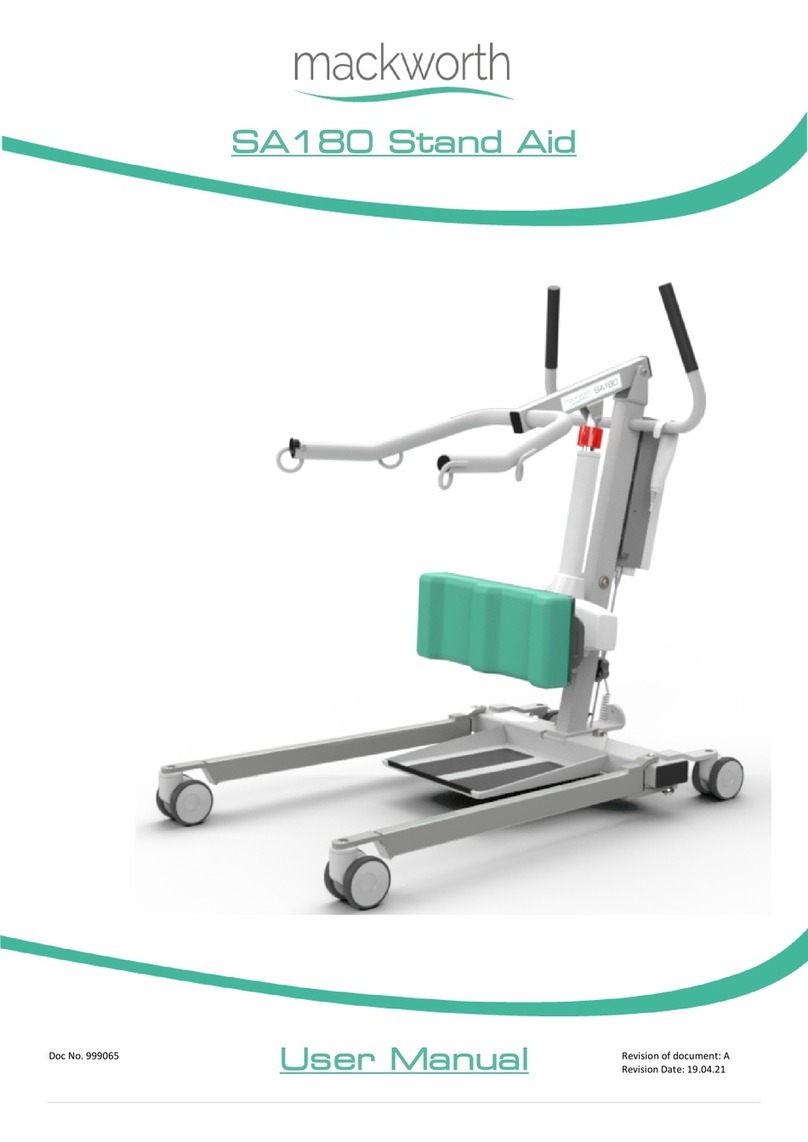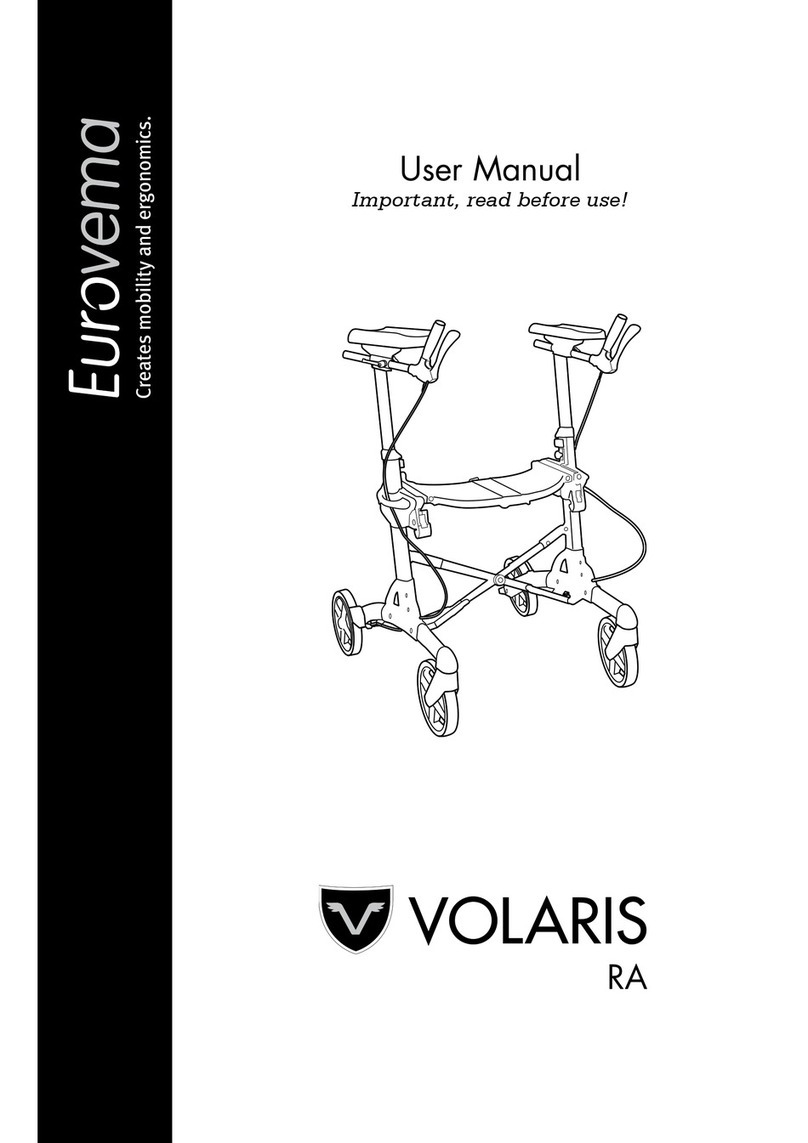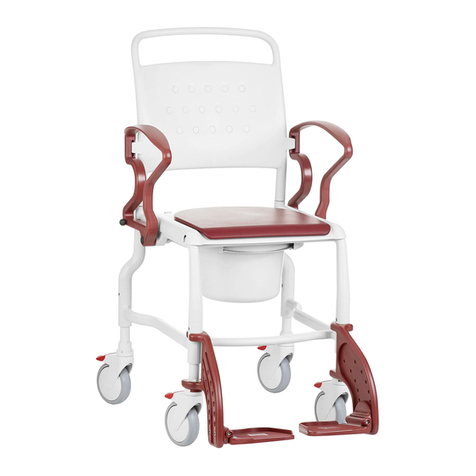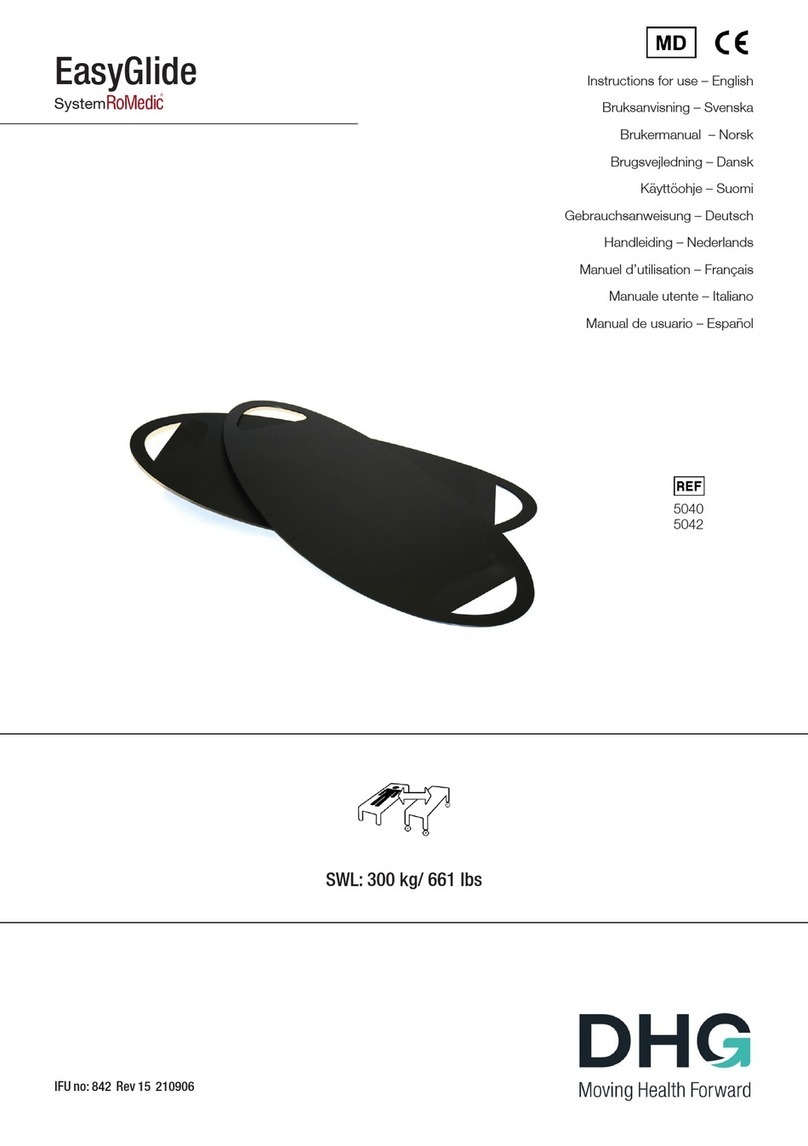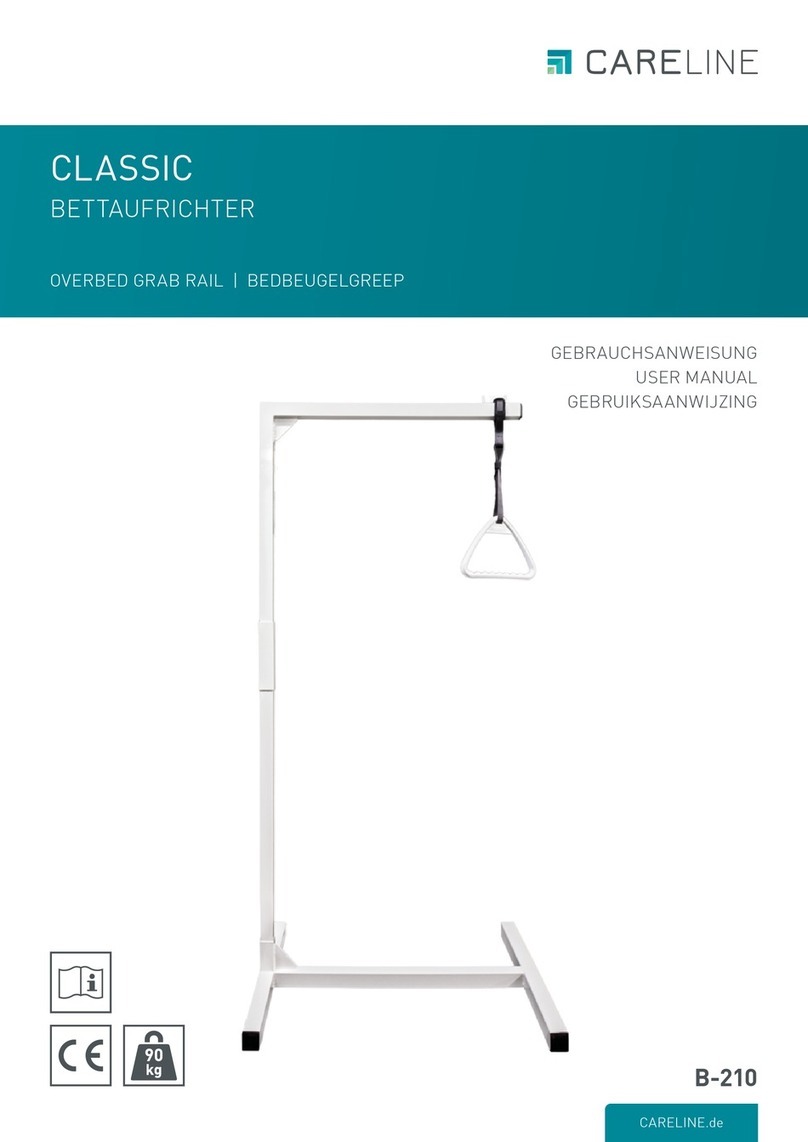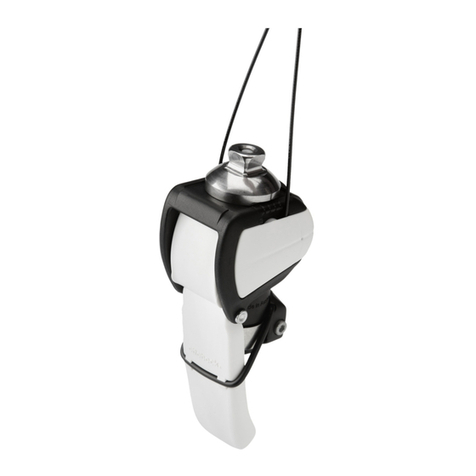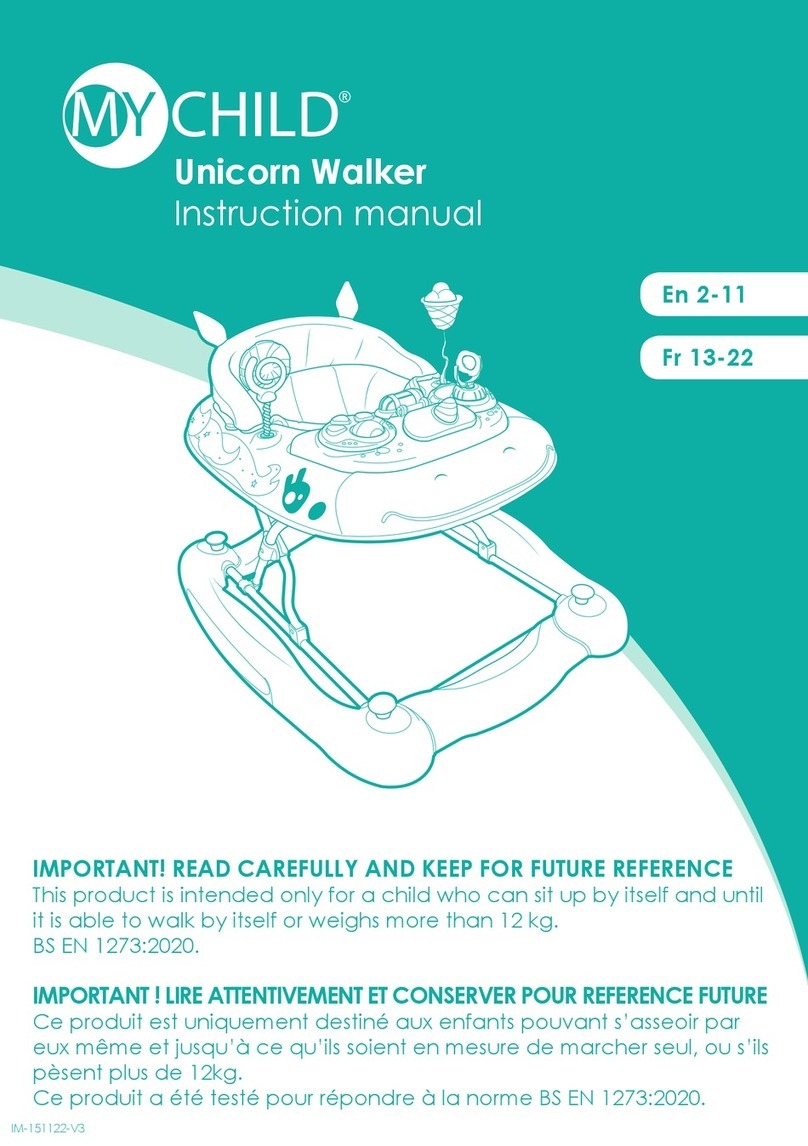MYOSWISS The Myosuit User manual

MYOSWISS AG
User Manual
The Myosuit

U S E R M A N U A L
The Myosuit
IMPORTANT
READ CAREFULLY BEFORE USE
KEEP FOR FUTURE REFERENCE
FOR USE WITH MYOSUIT REF: 1910001
FOR USE WITH MYOSUIT BATTERY REF: 1910002
MyoSwiss AG
Hardturmstrasse 135
CH-8005
https://myo.swiss
Document version: 3.8
Release date: March 24
th
, 2020
This user manual is subject to periodic reviews, updates, and revisions.
© Copyright 2020 MyoSwiss AG. All rights reserved.

Table of Contents
1 ............................................................................................................................................... 5
1.
Introduction .......................................................................................................................... 5
2.
Important information ......................................................................................................... 6
Safety .......................................................................................................................................... 6
Operator responsibility ............................................................................................................... 6
How to use this documentation ................................................................................................. 6
Symbols used in this manual ...................................................................................................... 7
Symbols used in the Myosuit ...................................................................................................... 7
Applicable classifications ............................................................................................................ 8
3.
Indications for use ................................................................................................................ 9
Indications .................................................................................................................................. 9
Contraindications ....................................................................................................................... 9
4.
Safety regulations .............................................................................................................. 10
5.
Myosuit components .......................................................................................................... 11
Functions of the Myosuit components ..................................................................................... 11
Operation modes ...................................................................................................................... 12
2 .............................................................................................................................................. 14
1.
Remote control ................................................................................................................... 14
Remote control functions ......................................................................................................... 14
Remote control button layout ............................................................................................... 14
Functions of the components of the remote control ............................................................... 15
Configuration screens ............................................................................................................ 16
Training screens ..................................................................................................................... 16
2.
Actuation unit ..................................................................................................................... 17
Components of the actuation unit ........................................................................................... 17
Functions of the actuation unit components ........................................................................... 17
3.
Harness ............................................................................................................................... 19
Components of the harness ..................................................................................................... 19
Functions of the harness components ..................................................................................... 19
4.
Knee orthoses ..................................................................................................................... 21
Components of the knee orthoses ........................................................................................... 21
Functions of the components of the knee orthoses ................................................................. 21
5.
Passive elements ................................................................................................................ 23
Components of the passive elements ...................................................................................... 23
Functions of the components of the passive elements ............................................................ 23
6.
Force routing sleeves .......................................................................................................... 25
Components of the force routing sleeve .................................................................................. 25

Functions of the components of the force routing sleeves ...................................................... 25
3 .............................................................................................................................................. 26
1.
Donning the Myosuit .......................................................................................................... 26
Preparing for the first training session ..................................................................................... 26
Defining the sizes of the hip belt ........................................................................................... 26
Defining the sizes of the thigh frame padding ...................................................................... 26
Defining the location of the shoulder straps and hip ligaments ........................................... 27
Donning procedure ................................................................................................................... 27
Myosuit preparation .............................................................................................................. 28
Donning the Myosuit ............................................................................................................. 29
Final adjustments .................................................................................................................. 32
2.
Doffing the Myosuit ............................................................................................................ 33
4 .............................................................................................................................................. 34
1.
Using the Myosuit .............................................................................................................. 34
Turning on the Myosuit ............................................................................................................ 34
Turning off the Myosuit ............................................................................................................ 35
Configuring a training session ................................................................................................... 36
Training with the Myosuit ........................................................................................................ 37
Training screen layout and feedback to the operator and user ............................................ 39
Navigating the training screens ............................................................................................. 39
Navigating in a training screen ........................................................................................... 40
Navigating between training screens ................................................................................. 41
Changing the assistance and calibration levels ..................................................................... 42
Calibrating the Myosuit for walking and stair negotiation .................................................... 42
Standing up from a chair ....................................................................................................... 42
5 .............................................................................................................................................. 43
1.
Maintenance, battery care, cleaning, and storing the Myosuit ......................................... 43
Maintenance ............................................................................................................................. 43
Battery care .............................................................................................................................. 43
Changing the battery ............................................................................................................. 44
Charging the battery .............................................................................................................. 44
Cleaning .................................................................................................................................... 45
Storage ...................................................................................................................................... 45
Inspecting the Myosuit ............................................................................................................. 45
Disposing of the Myosuit .......................................................................................................... 45
2.
Troubleshooting ................................................................................................................. 46
Information messages .............................................................................................................. 46
Errors ........................................................................................................................................ 47
6.
Reporting undesirable events ............................................................................................. 50
6 .............................................................................................................................................. 51
1.
Technical data and specifications ....................................................................................... 51
Capacity .................................................................................................................................... 51
Operating conditions ................................................................................................................ 51
Storage conditions .................................................................................................................... 52
Other specifications .................................................................................................................. 52
2.
Index ................................................................................................................................... 53

M Y O S U I T – U S E R M A N U A L
Page 5 of 53
1. Introduction
This user manual introduces the Myosuit, its components, operating procedures, and
provides a troubleshooting guide.
The Myosuit is a wearable robotic device that assists users in training activities of daily life such as sitting transfers,
walking, or negotiating stairs. The design of the Myosuit is based on the analysis of kinematic and kinetic data to
identify the muscles involved in supporting the body during these activities. It is a novel approach to provide
users with an extra layer of wearable muscles to support their training during activities of daily life.
Figure I. Working principle of the Myosuit. The tension of an external tendon—routed behind the hip joint and in front of the knee
joint—is regulated actively to assist the user with the extension of both joints. Ligaments support passively the flexion of the hip and
ankle joints.
For any questions regarding this user manual and/or operation of the Myosuit, please contact:
MyoSwiss AG
Hardturmstrasse 135
CH-8005
Tel.: +41 43 215 27 15
support@myoswiss.com
MyoSwiss Deutschland GmbH
Strasse der Republik 4
Bitterfeld-Wolfen 06766
Tel.: +49 349 4657 9180
support@myoswiss.com
Part
1

M Y O S U I T – U S E R M A N U A L
Page 6 of 53
2. Important information
Please read this user manual carefully prior to using the Myosuit. Make sure that you understand all the
instructions provided and are comfortable with using the Myosuit prior to operating it. If there any questions, or
portions of this manual which are not clear, please contact MyoSwiss for clarification prior to operating the
Myosuit.
The Myosuit must be operated only by trained personnel. Training must be provided by MyoSwiss-approved
personnel. If additional training is needed, please request it from MyoSwiss.
Training is mandatory prior to using the Myosuit. This document
serves as a guide during training and a reference after training.
This manual is not a substitute for training.
Safety
Never modify the system in any way. Modifications by non-approved personnel may affect the safety and
performance of the Myosuit. Anyone operating the Myosuit must understand all the safety instructions described
in this user manual prior to operating the Myosuit.
Operator responsibility
The operator is responsible to ensure that anyone operating the system has read and understood this user manual
and its safety instructions. Anyone who reads this manual, however, is not guaranteed to be qualified to operate
the Myosuit. Proper training by MyoSwiss-approved personnel must be carried out with each person involved in
the operation of the Myosuit.
The operator is responsible for guiding the user through the operation of the Myosuit and to ensure, to the best
of his or her abilities, the safety of the user while using the Myosuit.
MyoSwiss AG disclaims all liability for injuries to persons or
damage to material whenever the safety and operating instructions
for the Myosuit are ignored.
How to use this documentation
The user manual contains the information necessary when using the Myosuit.
The document first introduces the Myosuit (Part I). It then describes the components of the Myosuit in detail
(Part 1) and the detailed instruction on using the Myosuit (Part 2). The final section provides general information
about the storage and maintenance of the Myosuit (Part 3).

M Y O S U I T – U S E R M A N U A L
Page 7 of 53
Symbols used in this manual
Symbol Meaning of the symbol
Caution. Please consult the safety instructions. General warning and safety notices.
General information, tips, and comments about operating the Myosuit.
Symbols used in the Myosuit
Symbol Meaning of the symbol
Caution
Refer to instruction manual/booklet
Not for general waste
Manufacturer
Protected against solid objects over 12.5mm e.g. hands, large tools.
Protected against falling drops of water, if the case is disposed up to 15° from vertical.
Type B applied part
Contains natural rubber latex
Do not wash
Manual cleaning
Keep away from flames, fire, or excessive temperatures
Do not drop or impact the battery against hard objects

M Y O S U I T – U S E R M A N U A L
Page 8 of 53
Symbol Meaning of the symbol
Do not store the battery when discharged
Keep dry
Use only the charger provided for the battery
Medical device
Reference number
Lot number
Serial number
Applicable classifications
EN 60601-1 Protection against electrical shock: Internally powered me equipment.
EN 60601-1 Applied parts: Type B applied parts.
EN 60601-1 Mode of operation: Continuous operation.

M Y O S U I T – U S E R M A N U A L
Page 9 of 53
3. Indications for use
Users with unilateral or bilateral lower limb paresis, or flaccid paralysis, or muscle weakness due to neurological
and neuromuscular disorders e.g. multiple sclerosis, muscle dystrophy, stroke; trauma i.e. incomplete spinal cord
injury; or aging e.g. sarcopenia can benefit from the device by compensating for their disability during training.
Indications
Be able to stand up from a chair without deviating during the movement from the sagittal body plane by
more than 45 degrees compared to the sagittal body plane while sitting on a chair.
Be able to walk 10 m without the assistance of another person, but can be assisted by traditional assistive
devices except knee orthoses (e.g. cane/crunch, ankle foot orthosis)
Physical prerequisites such as muscle status, mobility grade and axis deviations that guarantee proper
control of the orthoses are crucial.
The patient must fulfil the physical and mental requirements for the perception of audible signals.
Height is between 150cm and 195cm (59.06inch to 76.77inch).
Weight is between 45kg and 110kg (100lbs to 275lbs).
Contraindications
Functional reach test < 15.24cm/6inch
Flexion contracture in the knee and hip joint in excess of 10°
Varus malposition in excess of 10° or valgus malposition in excess of 10°
Body weight over 110 kg/275 lbs
Body weight less than 45 kg/100 lbs
Body height less than 150 cm/59.06 inch
Body height over 195 cm/76.77 inch
Pregnancy

M Y O S U I T – U S E R M A N U A L
Page 10 of 53
4. Safety regulations
Do not use the Myosuit prior to reading and understanding this
manual.
Do not conduct training with the Myosuit if the harness and/or
knee orthoses do not fit the user properly.
Check the harness and knee orthoses before every training session.
Do not conduct training if there is visible damage on any
components of the Myosuit. Please contact MyoSwiss in such
cases.
Stop training immediately if there are faults or abnormalities from
the Myosuit.
Servicing or repairs must be performed only by MyoSwiss-
approved personnel.
Servicing or repairs must never be performed while the system is in
use.
Do not modify this equipment without authorization from
MyoSwiss.
Do not remove the cover from any components of the Myosuit.
If any serious injury occurs while using the Myosuit, MyoSwiss
must be notified immediately.

M Y O S U I T – U S E R M A N U A L
Page 11 of 53
5. Myosuit components
Figure 5.1. The Myosuit and its components
Functions of the Myosuit components
ID Component Function
1 Remote control
The remote control is the main interface to control the functions of
the Myosuit.
2 Actuation unit
The actuation unit is the rigid box located in the back of the harness.
It holds the motors that
tension the tendons that support the user’s
movements.

M Y O S U I T – U S E R M A N U A L
Page 12 of 53
ID Component Function
3 Harness
The harness holds the actuation unit and battery of the Myosuit. It
attaches
to the user using the shoulder straps, hip belt, and sternum
strap.
4 Knee orthosis
The knee orthoses help
to route the forces from the actuation unit
along the user’s legs.
This routing of the forces helps with the extension of the
hip and knee
joints.
A Myosuit uses two knee orthoses: for the left and right legs of the
user.
5 Passive elements
The passive elements are a set of rubber-band-
like elements that assist
with the flexion of the user’s hip, knee, and ankle joints.
Each Myosuit includes at least two hip ligaments and two ankle
ligaments (not shown in the image).
6 Tendon routing sleeves Tendon routing sleeves.
7 Sensor cables The sensor cables carry the inform
ation from sensors in the knee
orthoses to the actuation unit.
8 Battery charger
(not shown in the
figure) The battery charger is used to charge the batteries of the Myosuit.
Operation modes
Mode Description
Configuration mode
This is the initial mode of operation of the Myosuit.
The operator selects who is the operator and who is the user for the current
training session.
No tension is applied to the tendons during the configuration process.
Training modes
Once the configuration for a training session has been set, the training session
is carried out using a combination of training modes.
Transparency mode This is the initial mode of operation in training.

M Y O S U I T – U S E R M A N U A L
Page 13 of 53
Mode Description
In this mode, the tension of the tendons is kept to a minimal. The motors in
the actuation unit are audible in this mode.
Isometric force mode
In this mode, the tension of the Myosuit tendons is kept constant. The t
ension
can be adjusted between six levels of tension.
For example, during balance
training.
Concentric force mode
In this mode, the Myosuit assist the user when moving against gravity. For
example, when walking, ascending stairs, or standing up from a chair.
Eccentric force mode
In this mode, the Myosuit assists the user when moving with gravity. For
example, when sitting down.

M Y O S U I T – U S E R M A N U A L
Page 14 of 53
1. Remote control
The remote control is the main interface to control the functions of the Myosuit.
Remote control functions
Remote control button layout
Figure 2.1.1 Remote control and its components
Part
2

M Y O S U I T – U S E R M A N U A L
Page 15 of 53
Functions of the components of the remote
control
ID Component Function
1.1 Remote control screen The remote control screen
displays the information about the current status
of the Myosuit. It provides general guidance when using the Myosuit.
1.2 Light indicator The light
indicator is an additional indicator of the current state of the
Myosuit.
1.3 Standby button
The standby button is used to power the Myosuit ON and OFF.
When the Myosuit is OFF, a short press of the standby
button turns the
Myosuit ON.
When the Myosuit is ON, a long press of the standby
button turns the
Myosuit OFF.
1.4 Navigation button
The navigation button is used to navigate around the screens.
A short press of the button navigates in a clockwise direction.
A long press of the button (0.5 seconds)
navigates in a counterclockwise
direction.
1.5 Left arrow button
In configuration mode: the left arrow b
utton is used to navigate to the
previous configuration screen.
In training mode: the left arrow button is used to navigate between training
modes and to adjust the force and calibration values of each leg.
1.6 Right arrow button
In configuration mode: the right arrow button is used to navigate to the next
configuration screen.
In training mode: the right arrow button is used to navigate between training
modes and to adjust the force and calibration values of each leg.
1.7 Action button
In the last screen of configuration mode: the
action button is used to start the
training mode.
In training mode: the action button is used to switch between a given training
mode and transparency mode.
This button only accepts long presses (0.5 seconds).

M Y O S U I T – U S E R M A N U A L
Page 16 of 53
Configuration screens
Detailed information on how to operate the Myosuit is provided in Part 2 of this user manual. The following
screen samples are shown for general reference.
Figure 2.1.2 Configuration screens
Training screens
Figure 2.1.3. Training screens

M Y O S U I T – U S E R M A N U A L
Page 17 of 53
2. Actuation unit
The actuation unit is the rigid box located in the back of the harness. It holds the motors
that produce the force that is then transmitted to the user.
Components of the actuation unit
Figure 2.2.1 Actuation unit and its components
Functions of the actuation unit components
ID Component Function
2.1 Battery The battery provides the energy needed to power the Myosuit.
2.2 Battery release button The battery release button helps connect and disconnect the battery
from the
actuation unit.

M Y O S U I T – U S E R M A N U A L
Page 18 of 53
ID Component Function
In case of an emergency during operation,
the battery can be quickly released using the battery
release button. This will turn off the Myosuit
immediately.
2.3 Cooling vents
The cooling vents should not be blocked
when the Myosuit is being used. This
may cause the Myosuit to overheat.
The cooling vents facilitate the flow of air in the actuation unit.
2.4 Tendons
The tendons are the elements that transmit the forces from the actuation unit
along the knee orthoses and finally to the user.
2.5 Battery charging port
The battery charging port is where the battery charger needs to be connected
for proper charging of the battery.
2.6 Battery support rails The battery support rails help slide the battery in and out of the actuation unit.

M Y O S U I T – U S E R M A N U A L
Page 19 of 53
3. Harness
The harness holds the actuation unit and battery of the Myosuit. It attaches to the user using
the shoulder straps, hip belt, and sternum strap.
Components of the harness
Figure 2.3.1. Harness and its components
Functions of the harness components
ID Component Function
3.1 Shoulder straps The shoulder straps help position the Myosuit on the user.
3.2 Hip belt
The hip belt is the main anchor point to support the forces from the Myosuit
on the user.
The hip belt is made up of an inner and an outer belt.
3.3 Sternum (chest) strap
The sternum (chest) strap provides additional support to better distribute the
forces to the user’s upper body.
3.4 Handle
The handle is not intended for use with a
body weigh support system.
The handle can be used to facilitate carrying the Myosuit.

M Y O S U I T – U S E R M A N U A L
Page 20 of 53
ID Component Function
3.5 Harness cover and
attachment
The harness includes a textile cover that protects the actuation unit. The cover
has two attachment points that connect the cover to the shoulder straps.
3.6 Shoulder strap attachment
The shoulder strap attachment connects the shoulder strap
to the inner hip
belt via a plastic hook.
3.7 Hip ligament attachment The
hip ligament attachment connects the hip ligament to the inner hip belt
via a plastic hook.
3.8 Hip belt hook The hip belt hook secures together both sides of the outer hip belt
3.9 Remote control attachment
(not shown)
The remote control can be attached on the front or the back of the right
shoulder strap.
Table of contents
Popular Mobility Aid manuals by other brands
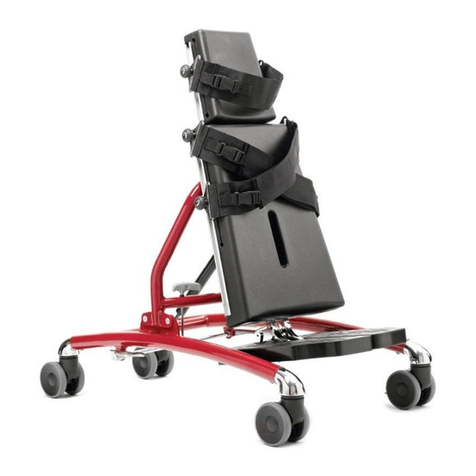
R82
R82 Caribou user guide
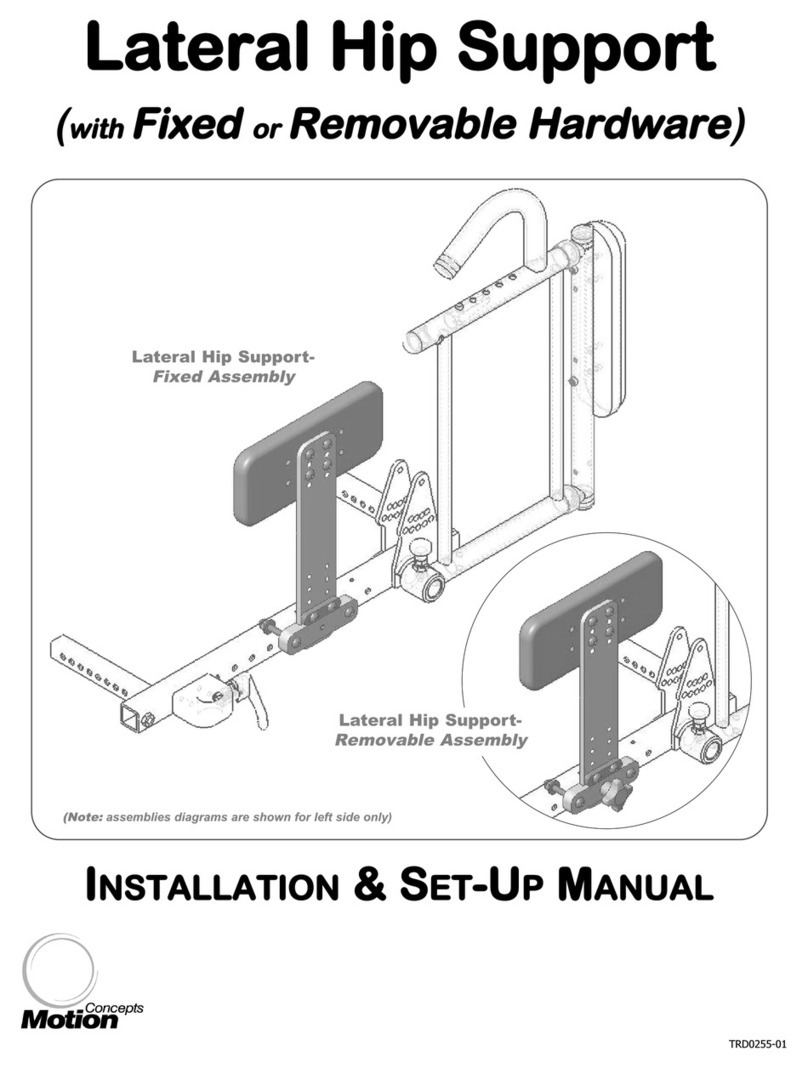
Motion Concepts
Motion Concepts Lateral Hip Support Installation setup manual
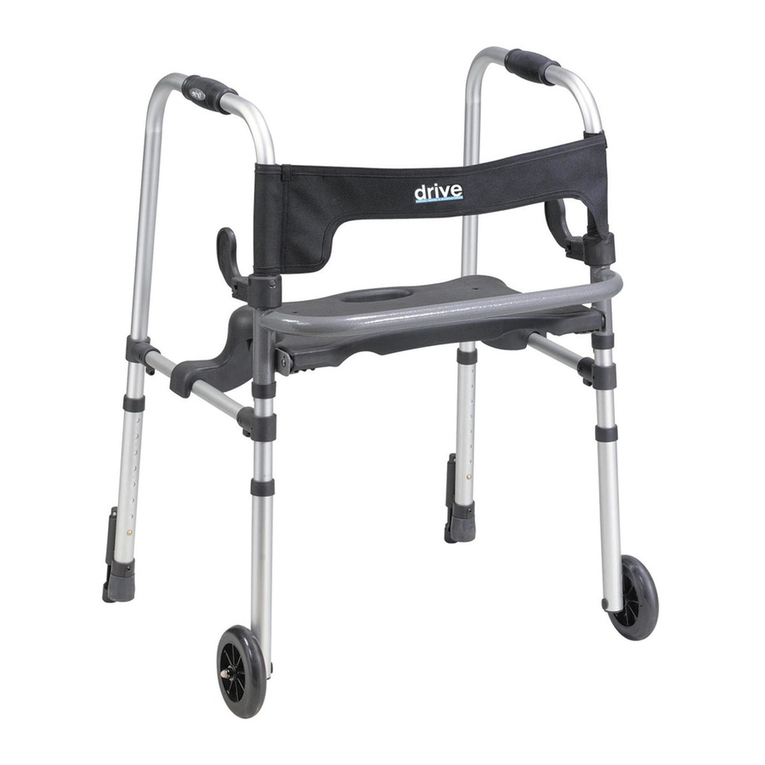
Drive
Drive Clever-Lite LS manual
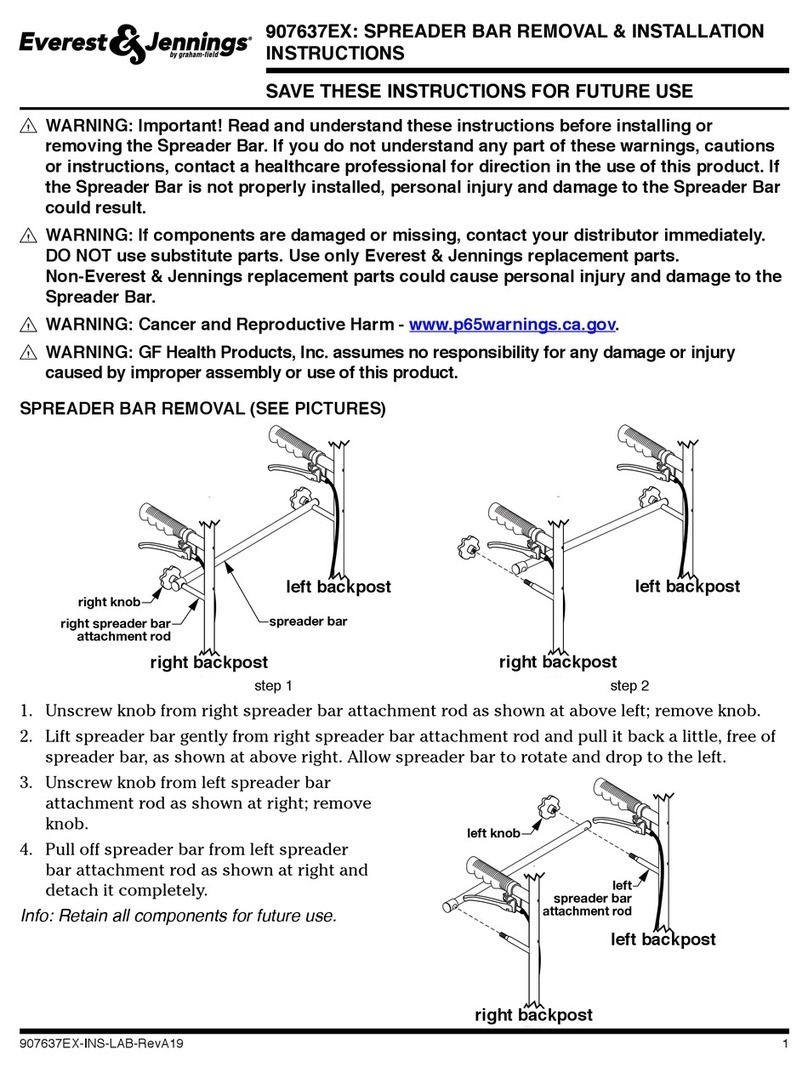
Graham Field
Graham Field Everest & Jennings 907637EX Removal/Installation Instructions
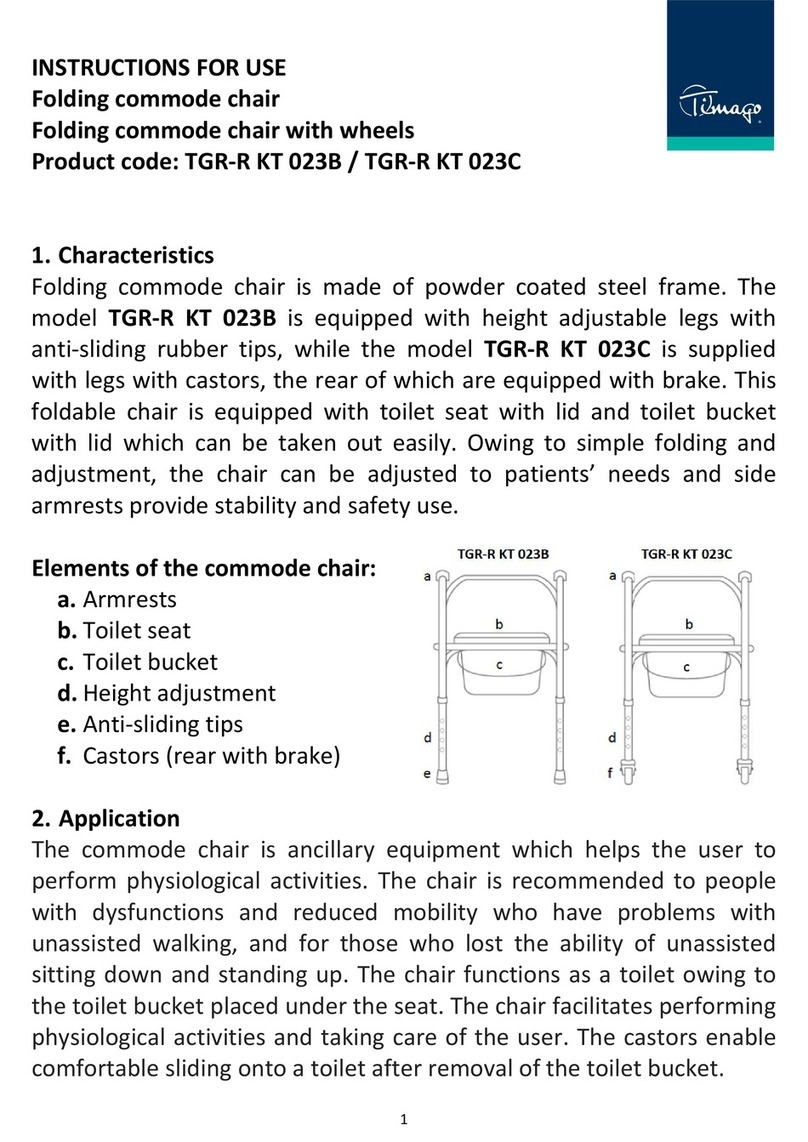
Timago
Timago TGR-R KT 023B Instructions for use

Ki Mobility
Ki Mobility Tyke Technical manual
